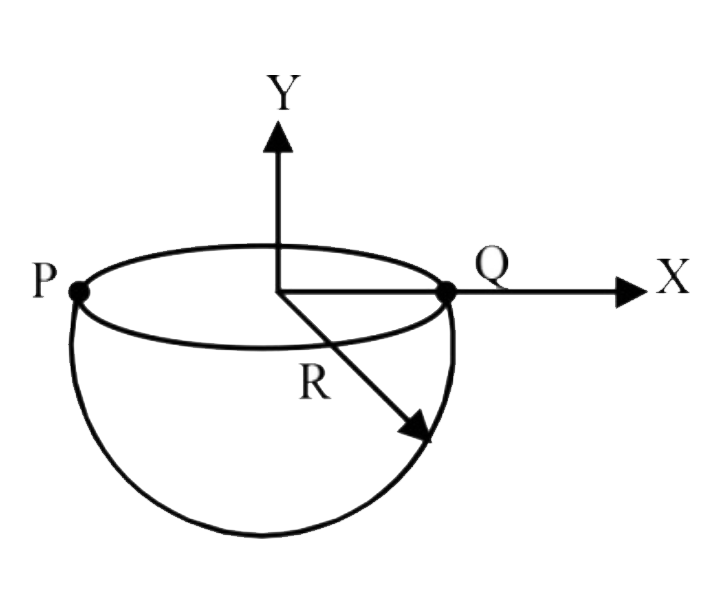What is the amount of work done in bringing a mass from the surface of Earth on one side to a point diametrically opposite on the other side?
To solve the problem of finding the amount of work done in bringing a mass from the surface of the Earth on one side to a point diametrically opposite on the other side, we can follow these steps:
1. Understanding the Problem: We need to find the work done in moving a mass m from one point on the surface of the Earth to the diametrically opposite point.
2. Potential Energy Formula: The gravitational potential energy U at a distance r from the center of the Earth is given by the formula:
U=−GMmr
where G is the gravitational constant, M is the mass of the Earth, and r is the radius of the Earth.
3. Initial Potential Energy: Let’s denote the initial position of the mass as point A. The potential energy at point A (initial position) is:
Ui=−GMmR
where R is the radius of the Earth.
4. Final Potential Energy: The final position of the mass is point B, which is diametrically opposite to point A. The potential energy at point B (final position) is:
Uf=−GMmR
5. Calculating Work Done: The work done W in moving the mass from point A to point B is given by the change in potential energy:
W=Uf−Ui
Substituting the values we have:
W=(−GMmR)−(−GMmR)
Simplifying this gives:
W=−GMmR+GMmR=0
6. Conclusion: Therefore, the amount of work done in bringing the mass from one side of the Earth to the diametrically opposite side is:
W=0 joules
U=−GMmr
where G is the gravitational constant, M is the mass of the Earth, and r is the radius of the Earth.
Ui=−GMmR
where R is the radius of the Earth.
Uf=−GMmR
W=Uf−Ui
Substituting the values we have:
W=(−GMmR)−(−GMmR)
Simplifying this gives:
W=−GMmR+GMmR=0
W=0 joules
Topper's Solved these Questions
- BOOK - VMC MODULES ENGLISHCHAPTER - GRAVITATIONEXERCISE - LEVEL -0 Short Answer Type – II13videos
GRAVITATION
- BOOK - VMC MODULES ENGLISHCHAPTER - GRAVITATIONEXERCISE - LEVEL -0 Long Answer Type3videos
GRAVITATION
- BOOK - VMC MODULES ENGLISHCHAPTER - GRAVITATIONEXERCISE - JEE Advance (Archive) TRUE/FALSE1videos
GRAVITATION
- BOOK - VMC MODULES ENGLISHCHAPTER - GASEOUS STATE & THERMODYNAMICSEXERCISE - JEE ADVANCED (ARCHIVE )111videos
GASEOUS STATE & THERMODYNAMICS
- BOOK - VMC MODULES ENGLISHCHAPTER - INTRODUCTION TO VECTORS & FORCES EXERCISE - JEE Advanced ( ARCHIVE LEVEL-2)12videos
INTRODUCTION TO VECTORS & FORCES
Similar Questions
What is the work done in taking an object of mass 1kg from the surface of the earth to a height equal to the radius of the earth ?
(G=6.67×10−11Nm2/Kg2, Radius of the earth = 6400 km, Mass of the earth =6×1024kg.)View SolutionWhat is the amount of work done in moving a charge of 15 between two points kept at a potentia difference of 1.2 V?
View SolutionThe work done to raise a mass m from the surface of the earth to a height h, which is equal to the radius of the earth, is :
View SolutionWhat is the work done in shifting a body of mass m=5okg slowly from the earth's surface to infinity?
View SolutionThe work that must be done in lifting a body of weight P from the surface of the earth to a height h is
View SolutionA hollow hemisphere of mass 4m is placed as shown in figure . Two point masses m each are fixed to it at points P and Q on diametrically opposite points. The position of center of mass of the system is
 View Solution
View SolutionProve that in a triangle, if the square of one side is equal to the sum of the squares of the other two sides, then the angles opposite to the first side is a right angle.
View SolutionProve that in a triangle if the square of one side is equal to the sum of the squares of the other two side then the angle opposite to the first side is a right angle.
View SolutionA particle is moving in a circle with uniform speed v . In moving from a point to another diametrically opposite point
View SolutionThe amount of work done in blowing a soap bubble such that its diameter increases from d to D is (T=surface tension of the solution)
View Solution

